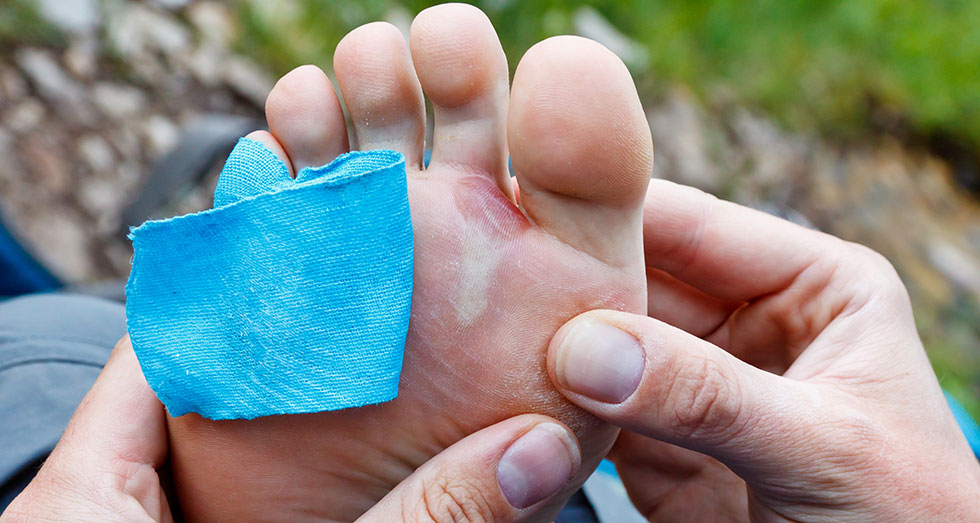It’s that time of year again: you’re enjoying the great outdoors when you notice a “hot spot” on your foot (it’s a blister), and then you realize that your arm is itchy—likely from contact with an unidentified plant.
This isn’t going to happen every time you go out, and you probably don’t get, say, blisters and poison ivy rashes in the same outing, but wouldn’t you like to know how to treat them using items you have at home?
Blisters
Obviously, the best “treatment” for a blister is prevention.
To prevent blisters, wear shoes that fit and moisture-wicking sock liners, and use gloves for yard work and other heavy lifting. But even when we take the best precautions, we can still sometimes get those irritating sores.
Here are some natural and herbal remedies for blisters:

NATURAL TREATMENTS
- Pure Aloe Vera Gel – This seems to be the balm of all balms (it can be used for itchy skin as well, see below). The University of Maryland Medical Center’s website says that aloe is a natural anti-inflammatory that is superior to hydrocortisone cream! This means that it will help relieve swelling and redness. Plus, it’s also a great hydrator and will help keep the skin moist, which helps with healing. The great news is that you can easily grow Aloe Vera in your home or garden. This would also be a great addition to your preparedness supplies (although you would probably use the less-potent bottled version for storage).
- Baking Soda – Mix with water to make a paste and allow it to dry on the blister (you can also add salt to the mix). This paste will dry out the blisters, reduce inflammation and pain, and kill bacteria.
- Turmeric and Honey – Both of these items are antibacterial and healing agents. Mix the two together and apply on the blister.
- Apple Cider Vinegar – Raw, organic, unfiltered works the best. Apply to new blisters (not broken ones—ouch!).
HERBAL REMEDIES
- Marigold – This helps open blisters to heal (infuse a teaspoon of flowers to a glass of water and wet the affected area).
- Chamomile – This is an antiseptic and can aid in healing (infuse dried flowers in four cups of water for 15 minutes. Apply wet compress to affected area).
- Garlic – A natural disinfectant! (rub affected area with garlic juice).
Itchy Skin
Itchy and irritated skin can be, well… irritating. You can use Aloe Vera Gel and Apple Cider Vinegar for irritated skin as well as blisters! But if you don’t have those on hand, here are some ways to relieve the itch.

- Bentonite Clay: Not only is this clay great for skin irritation, but it can also help heal wounds from venomous stings and bites (this would be a great addition to your preparedness kit). You should use virgin, untreated clay and then mix with water until creamy (like peanut butter). Dab onto affected areas and then rinse or peel off. You can also do a clay pack by spreading the clay on a clean, porous fabric (wool, muslin, cotton, flannel), placing the side with the clay on the affected area, and bandage it up (this makes it last about 4 hours until the clay dries). You can also substitute apple cider vinegar for water when preparing your clay to use both at the same time!
- Peppermint Leaves – This is another plant you can grow at home. Peppermint leaves are great for itching (and bug bites) because they provide a cooling sensation for relief. Just crush up the leaves and rub the peppermint directly on the skin (or freeze the leaves and then use them later for an extra cooling rush!).
- Basil Leaves – Basil actually contains anti-itch compounds called camphor and thymol. Plus, it’s delicious, so you should definitely grow some. Just crush up the leaves and rub on the skin.
- Fruit Peels – You can take a banana peel or watermelon rind (or any other fruit with a peel) and rub it on the affected area. Just don’t use this remedy if you’re going to be outdoors because it can attract bugs. (And remember to wash the banana peel or rind before applying it to your skin—check out this post to see why. Yuck.)
- Oatmeal – Oatmeal is an anti-inflammatory and can be used as a poultice or bath. Just add plain, uncooked oatmeal to a bath or add a bit of water to some oatmeal and wait until it reaches a paste-like consistency, then apply to the affected area.
These are just a few suggestions for treating your skin, and the best part is that you can grow many of them yourself. Do you have any natural remedies that have worked on your blisters or skin irritation?
Sources:
Botanical Online Gerson Institute
Disclaimer: This post is for informational purposes only. Always consult a medical professional for treatment, especially if any of the above treatments fail to work or cause the condition to worsen.


2 comments
Kathy Kodra
My spouse caught the trunk of my nearly mature cherry tree and gouged a hand span of bark from it down to the cambium of the tree. I mixed sugar and water in a slurry/paste and slathered it onto the wound replaced the missing bark and secured it all with some gorilla tape. Tree went on to produce a bumper crop with no ill effects. Will take the tape off before winter but sugar works wonders in healing.
TAMME
TABLE SUGAR with bandage will cure with no scarring …
also can cure gaine green…do the perimeter with petroleum jelly, place sugar in the center , wrap to keep in place. AMAZING SKIN HEALER